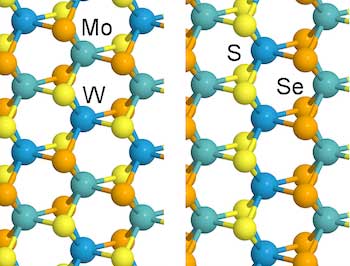| Posted: Sep 21, 2017 |
Four elements make 2-D optical platform
(Nanowerk News) Rice University scientists have discovered a two-dimensional alloy with an optical bandgap that can be tuned by the temperature used to grow it.
|
|
The Rice lab of materials scientist Pulickel Ajayan grew the four-component alloy of transition metals molybdenum and tungsten with chalcogens sulfur and selenium in a chemical vapor deposition furnace. They found changes in temperature made subtle changes in the way atoms assembled and also altered the properties that determine how they absorb and emit light.
|
 |
| Subtle changes in growth temperature alters the form of a four-component alloy created at Rice University. The alloy can be tuned to alter its optical bandgap, which may be of use in the design of solar cells and light-emitting diodes. (Illustration by Alex Kutana)
|
|
Their experiments were built upon work by the lab of Rice theoretical physicist Boris Yakobson, which created scores of models to predict how various combinations of the four elements should work.
|
|
The process should be of interest to engineers looking to make smaller, more-efficient devices. Because the bandgap falls in the optical range of the electromagnetic spectrum, the researchers said solar cells and light-emitting diodes might be the first beneficiaries.
|
|
The paper appears as a cover story in the current issue of Advanced Materials ("Quaternary 2D Transition Metal Dichalcogenides (TMDs) with Tunable Bandgap").
|
|
The team led by co-lead author and Rice research scientist Alex Kutana generated 152 random models of the material that showed the bandgap could be tuned from 1.62 to 1.84 electron volts by varying the growth temperature from 650 and 800 degrees Celsius (1,202 to 1,472 degrees Fahrenheit).
|
|
The experimental team led by Sandhya Susarla then made and tested the thermodynamically stable materials in a furnace at 50-degree increments. Scientists at Oak Ridge National Laboratory led by postdoctoral researcher Jordan Hachtel produced microscope images that identified and detailed the position of each atom in the materials.
|
|
“Labs have made 2-D materials with two or three components, but we don’t believe anyone has tried four,” said co-author and Rice postdoctoral researcher Chandra Sekhar Tiwary. “Having four components gives us an additional degree of freedom. With fewer materials, every adjustment you make to change the bandgap turns it into a different material. That’s not the case here.”
|
|
“What we’ve made should be very useful,” added Susarla, a Rice graduate student. “For applications like solar cells and LEDs, you need a material that has a broad bandgap.”
|
|
Tiwary said the material can be tuned to cover the entire spectrum of visible light, from 400- to 700-nanometer wavelengths. “That’s a huge range we can cover by just changing this composition,” he said. “If we choose the composition correctly, we can hit the correct bandgap or correct emission point.”
|
|
“These materials are arguably the most important 2-D semiconductors because of their excellent optoelectronic properties and low cost,” Kutana said. “Our high-throughput calculations permitted us to avoid prior assumptions about how the alloy bandgap behaved. The surprising outcome was how regular the bandgap changes were, resulting in optical properties that are both useful and predictable.”
|

